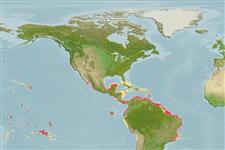Environment: milieu / climate zone / depth range / distribution range
Ekologi
laut berasosiasi dengan karang; kisaran kedalaman 0 - 50 m (Ref. 9626). Tropical; 25°N - 23°S
Western Atlantic: Panama to Santa Catarina, Brazil (Ref. 57756). Eastern Pacific: Mexico to Peru (Ref. 5530).
Size / Weight / umur
Maturity: Lm ? range ? - ? cm
Max length : 30.0 cm TL jantan/; (Ref. 7251); common length : 20.0 cm TL jantan/; (Ref. 3798); Berat maksimum terpublikasi: 300.00 g (Ref. 5217)
Duri punggung (Keseluruhan (total)): 12; duri punggung lunak (Keseluruhan (total)): 16; Duri dubur 3; Sirip dubur lunak: 9. Body oblong, compressed and not very deep (depth contained 2.5 to 2.9 times in standard length); mouth large and terminal, its posterior end located at the same level as the posterior edge of the pupil; first gill arch with 19 to 25 gill rakers; dorsal fin notched, with 11 to 12 spines and 15 to 17 soft rays (XI-XII, 15-17); second anal spine slightly longer and stronger than third; scale series above lateral line oblique; body dark brown or silver gray; each scale bearing a pearly gray spot, the spots appearing to form lines following the scale series; lower part of preopercle with a black spot; caudal peduncle with a large dark spot; fins grayish (Ref. 55763). Scales below lateral line oblique; anal fin more heavily scaled than other species; silvery gray or brown on back, silvery on sides, with dark lines following oblique scale rows; a large black spot at caudal base (Ref. 13442).
Found over sandy and rubble bottoms; occasionally on coral reefs and rocky areas (Ref. 3798). Rarely in clear oceanic insular areas (Ref. 5217). Often found in schools (Ref. 3798). Juveniles encountered near the shore, over sandy bottoms near seagrass beds (Ref. 9626). Feeds on benthic invertebrates (Ref. 3798). Marketed fresh (Ref. 3798).
Life cycle and mating behavior
Kematangan | Reproduksi, perkembang biakan | Pemijahan | telur-telur | Fecundity | Larva
Oviparous, distinct pairing during breeding (Ref. 205).
McKay, R.J. and M. Schneider, 1995. Haemulidae. Burros, corocoros, chulas, gallinazos, roncos. p. 1136-1173. In W. Fischer, F. Krupp, W. Schneider, C. Sommer, K.E. Carpenter and V. Niem (eds.) Guia FAO para Identification de Especies para lo Fines de la Pesca. Pacifico Centro-Oriental. 3 Vols. FAO, Rome. (Ref. 9114)
Status IUCN Red List (Ref. 130435)
ancaman kepada manusia
Harmless
penggunaan manusia
Perikanan: nilai komersial kecil; Akuarium: Akuarium publik; umpan: usually
informasi lanjut
AcuanBudidaya airprofil budidaya airStrainGenetikaElectrophoresesDiturunkanPenyakit-penyakitPengolahanNutrientsMass conversion
mitraGambarStamps, Coins Misc.Suara-suaraCiguateraKecepatanTipe renangArea insangOtolithsOtakPenglihatan / visi
Alat, peralatan
laporan khas
muat turun XML
Sumber internet
Estimates based on models
Preferred temperature (Ref.
123201): 23.8 - 28.1, mean 27.1 °C (based on 282 cells).
Phylogenetic diversity index (Ref.
82804): PD
50 = 0.5000 [Uniqueness, from 0.5 = low to 2.0 = high].
Bayesian length-weight: a=0.01349 (0.00851 - 0.02138), b=3.03 (2.90 - 3.16), in cm total length, based on LWR estimates for this species & Genus-body shape (Ref.
93245).
Trophic level (Ref.
69278): 3.7 ±0.2 se; based on diet studies.
Generation time: 3.7 ( na - na) years. Estimated as median ln(3)/K based on 1
growth studies.
Daya lenting (Ref.
120179): sedang, Waktu penggandaan populasi minimum 1.4 - 4.4 tahun (Preliminary K or Fecundity.).
Fishing Vulnerability (Ref.
59153): Low to moderate vulnerability (34 of 100).
Nutrients (Ref.
124155): Calcium = 46.7 [16.0, 86.1] mg/100g; Iron = 0.58 [0.31, 1.03] mg/100g; Protein = 19.3 [17.4, 21.1] %; Omega3 = 0.145 [0.078, 0.231] g/100g; Selenium = 29.2 [17.4, 47.9] μg/100g; VitaminA = 101 [41, 245] μg/100g; Zinc = 1.2 [0.8, 1.8] mg/100g (wet weight);
